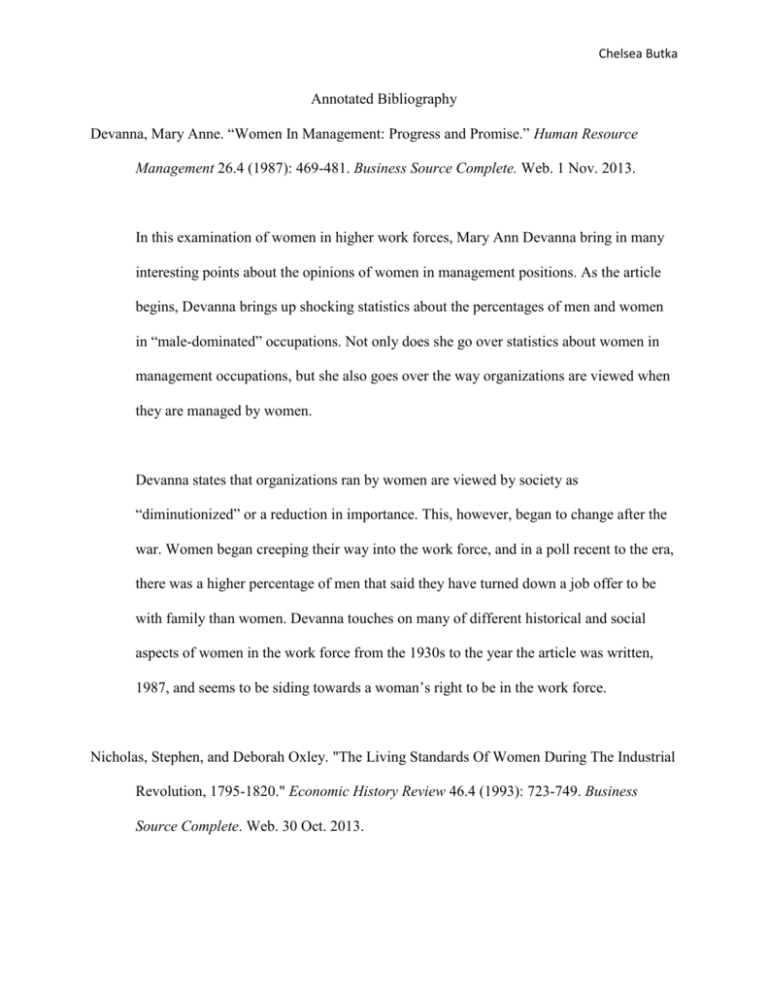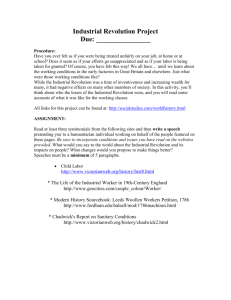Chelsea Butka Annotated Bibliography Devanna, Mary Anne
advertisement

Chelsea Butka
Annotated Bibliography
Devanna, Mary Anne. “Women In Management: Progress and Promise.” Human Resource
Management 26.4 (1987): 469-481. Business Source Complete. Web. 1 Nov. 2013.
In this examination of women in higher work forces, Mary Ann Devanna bring in many
interesting points about the opinions of women in management positions. As the article
begins, Devanna brings up shocking statistics about the percentages of men and women
in “male-dominated” occupations. Not only does she go over statistics about women in
management occupations, but she also goes over the way organizations are viewed when
they are managed by women.
Devanna states that organizations ran by women are viewed by society as
“diminutionized” or a reduction in importance. This, however, began to change after the
war. Women began creeping their way into the work force, and in a poll recent to the era,
there was a higher percentage of men that said they have turned down a job offer to be
with family than women. Devanna touches on many of different historical and social
aspects of women in the work force from the 1930s to the year the article was written,
1987, and seems to be siding towards a woman’s right to be in the work force.
Nicholas, Stephen, and Deborah Oxley. "The Living Standards Of Women During The Industrial
Revolution, 1795-1820." Economic History Review 46.4 (1993): 723-749. Business
Source Complete. Web. 30 Oct. 2013.
Chelsea Butka
In this economic historical review, Stephen Nicholas and Deborah Oxley study the living
standards of women during the industrial revolution, between the years 1795 and 1820.
Not only do they examine declining job opportunities, seasonal and intermittent
employment, poor working conditions, and unfavorable wage rates, they explore two
debates; one from the pessimist’s side, and one from the optimist’s side. The debate is
over one very controversial topic; did the Industrial Revolution help or hurt women’s
position in society?
Nicholas and Oxley’s research shows that pessimists argue that due to the Industrial
Revolution, women’s roles in society have been diminished. They give a quote from
Einstein, who was also a pessimist on this topic, and he says “industrialization intensified
women's family roles, creating a sphere of women's work that was unpaid when beyond
the market place, and low paid when in it”. On the other hand, the optimists have a very
different view. They believe that the Industrial Revolution “freed women from biological
constraints, opening up new job opportunities”. Both of these sides to the argument are
very interesting, and Nicholas and Oxley do a great job of researching and analyzing to
give light to both sides of the argument.
Lopez, Esther M. "Three Feminist Interventions.('The Feminist Utopian Novels Of Charlotte
Perkins Gilman: Themes Of Sexuality, Marriage, And Motherhood,' 'Working Women,
Literary Ladies: The Industrial Revolution And Female Aspiration,' And 'Feminist
Engagements: Forays Into American Literature And Culture')(Book Review)." Studies In
The Novel 3 (2011): 363. Academic OneFile. Web. 30 Oct. 2013.
Chelsea Butka
The text in this journal by Esther M. Lopez reviews feminist scholarship in the nineteenth
and twentieth American literature. There are three journals being reviewed here, the first
one being The Feminist Utopian Novels of Charlotte Perkins Gilman: Themes of
Sexuality, Marriage, and Motherhood, by Chloé Avril, then comes Working Women,
Literary Ladies: The Industrial Revolution and Female Aspiration by Sylvia Jenkins
Cook and finally Shelley Fisher Fishkin’s Feminist Engagements: Forays into American
Literature and Culture.
In the journal by Chloé Avril, she focuses on scholarship in utopian novels that illustrate
social and political views. Sylvia Jenkins Cook puts her effort into the scholarship of
working class women, which is often a group that is ignored. Finally, Shelley Fisher
Fishkin’s scholarship models an intersectional approach to literary studies; each of the
three sections of her book persuasively explains how looking at texts from multiple
perspectives enriches literary criticism. All three of these texts are very informational and
they are all journals that, when read in their entirety, provokes the mind to think in
different ways. They all write about things that no journalist has ever written about
before, therefore giving inspiration to many readers.
ROSENBURY, LAURA A.1,2. "Work Wives." Harvard Journal Of Law & Gender 36.2 (2013):
345-404. OmniFile Full Text Select (H.W. Wilson). Web. 30 Oct. 2013.
This article examines the determination of women to break their gender norms. This
article reviews what it means to be a “work wife” and backs up the thesis with
information including numerous laws on gender-neutral family laws and employment
Chelsea Butka
discrimination laws. In part one, Rosenbury examines the view of work wives in relation
to concerning family law, employment discrimination, and feminist legal theory.
In part two, Rosenbury examines the way that the gender roles of men and women have
relatively stayed apart from each other, despite the major change in women going out into
the work force. This academic journal is filled with not only facts from the law, but facts
from the work force and inside the everyday household.
GUTTERMAN, LAUREN JAE1, ljg300@nyu.edu. "The House On The Borderland": Lesbian
Desire, Marriage, And The Household, 1950-1979." Journal Of Social History 46.1
(2012): 1-22. OmniFile Full Text Select (H.W. Wilson). Web. 30 Oct. 2013.
In this academic journal, Lauren Jae Gutterman uses a very wide variety of sources to
support her thesis. With a very wide variety of interviews, diaries and letters, Gutterman
incredibly finds 160 wives who had expressed lesbian desires from the 1950s through the
1970s. She reviews the difference in women’s sexual tendencies from before and after the
war, and how women became more independent about their sexuality after the war.
This journal is very informational about the true thoughts and feelings women had in the
1950s to the 1970s. Gutterman does a great job in researching and finding the real, true
stories about women’s sexual orientations from before and after the war.
Chelsea Butka
Cowan, Ruth S. "The "Industrial Revolution" in the Home: Household Technology and Social
Change in the 20th Century." The Johns Hopkins University Press and the Society for the
History of Technology Vol. 17 (n.d.): 1-23. Print.
In this journal, Ruth S. Cowan compares families from before the Industrial Revolution
to after. She finds evidence to support that before the revolution, families were rather
large and produced nearly everything for themselves. Then after the revolution, families
began to shrink and started buying more goods. Rather than families living in rural areas,
more and more were living in the cities. Production for the household was no longer of
main importance; production was now meant for the market place.
This journal is a very important one to read, especially for my generation. Being born in
the 1990s, my generation has not experience a major revolution such as this. This was a
major game-changer in this time period. People went from living on farms and growing
their own food to working and living in the cities and buying their goods and services.
This teaches us that things could change in a matter of a few years, and to understand
what people really went through to make this change.
Chelsea Butka
Historical Overview
This annotated bibliography and historical overview explores the evolution in scholarship
on the changed gender roles of women during the Industrial Revolution. In journals in the early
1900s, many people were still very weary of the change of women’s roles from being a
housewife to being able to go out and get a good job and be a part of the economic society.
Women broke of their traditional ways of being a housewife and took on a more independent
role. There are still many journals being written today about this jump in social societies, but
rather than taking a reluctant approach as in the early 1900s, scholars now praise women in the
work force, making things before the Industrial Revolution for women sound unbearable. The
opinions of scholars go from being reluctant of women in the work force, to wondering why it
was such a struggle for women to be recognized as valued people in the work environment.
Today, women and men have equal rights in the work place and have just as many opportunities
as men.
With the approval of the Civil Rights Act in 1964, women have been able to be a part of
the work force. Therefore, in the mid-1900s, women being involved in the work force was still
fairly new. Scholars researched the progress that women were making towards being able to be
recognized as reputable and useful people in the work force. Many scholars wrote about how
women have not yet reached the top, but they were on their way. A good example of one of these
authors is Mary Anne Devanna. She wrote a journal entitled Women in Management: Progress
and Promise, which contains facts and statistics about women being in management positions.
As she researches about why women are less likely to get into management positions, she states
that “cultural blinders often override and make a shambles of evaluation and promotion systems
and a "glass ceiling" syndrome seems to prevent women from moving into senior management
positions” (Devanna, 2). Devanna writes of the struggles that women still have in the 1980s, how
Chelsea Butka
they are still not being treated like men are treated in work environments. As time goes on, so
does the revolution of women in the work force.
Besides the economic revolution, women also broke away from their traditional sexual
norms. In "The House On The Borderland” by Lauren Jae Gutterman, she examines 160 wives
who had expressed lesbian desires from the 1950s through the 1970s in diaries, letters and
memoirs. Because of this found information, we now realize that the Industrial Revolution
changed more for women than just giving them the chance to be able to work. The Industrial
Revolution gave them the freedom to have lesbian relationships right in their own homes. They
began to have secret relationships, but by the 1970s, women were openly telling their husbands
of the affairs (Gutterman, 1).
Today, scholarship of women in the work force and the Industrial Revolution are merely
history reviews. In The Living Standards Of Women During The Industrial Revolution, 17951820 by Stephen Nicholas and Deborah Oxley, these scholars research back to a time where
women were still suffering to become equal to men in the work force. They research “working
class living standards, and the changing position of women in the family and labor market as
traditional forms of production declined” (Nicholas, Oxley, 1).
Scholarship on the changed gender roles of women during the Industrial Revolution has
changed dramatically. In the mid-1900s, scholars were writing about women’s struggle to find
equality. Today, scholars write about whether the Industrial Revolution was good or bad for
women, and write historical reviews about what may have happened in the mid-1900s. The way
scholars approached this topic shows that things for women have changed very quickly; from the
Civil Rights Act being admitted in just 1964, to now, women have become accepted and valued
Chelsea Butka
in the work force in just under 50 years, and have broken their traditional “housewife” norms to
become more independent.








